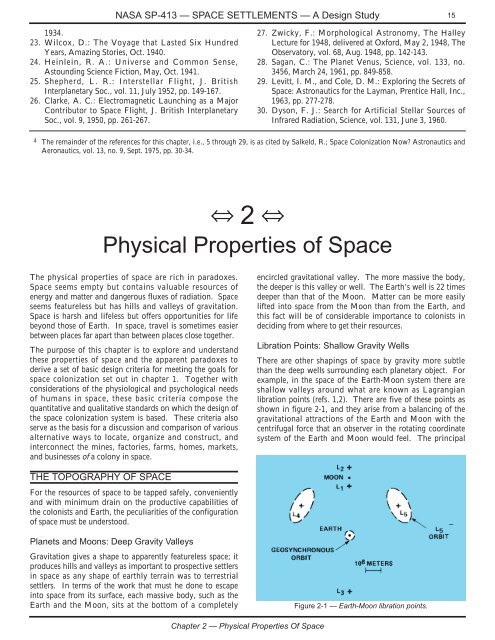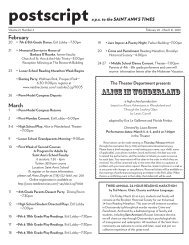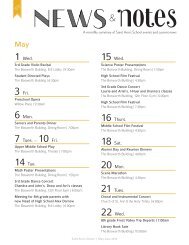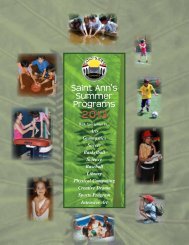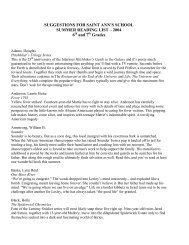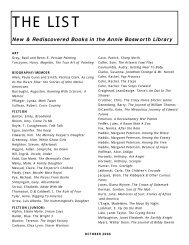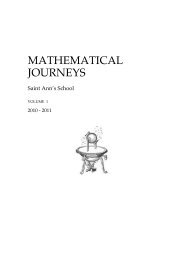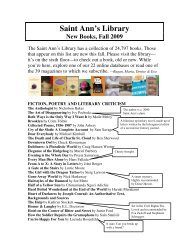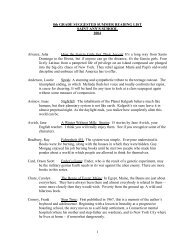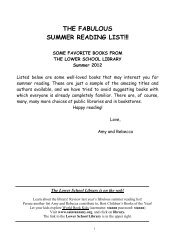NASA SP-413 Space Settlements - Saint Ann's School
NASA SP-413 Space Settlements - Saint Ann's School
NASA SP-413 Space Settlements - Saint Ann's School
Create successful ePaper yourself
Turn your PDF publications into a flip-book with our unique Google optimized e-Paper software.
<strong>NASA</strong> <strong>SP</strong>-<strong>413</strong> — <strong>SP</strong>ACE SETTLEMENTS — A Design Study<br />
15<br />
1934.<br />
23. Wilcox, D.: The Voyage that Lasted Six Hundred<br />
Years, Amazing Stories, Oct. 1940.<br />
24. Heinlein, R. A.: Universe and Common Sense,<br />
Astounding Science Fiction, May, Oct. 1941.<br />
25. Shepherd, L. R.: Interstellar Flight, J. British<br />
Interplanetary Soc., vol. 11, July 1952, pp. 149-167.<br />
26. Clarke, A. C.: Electromagnetic Launching as a Major<br />
Contributor to <strong>Space</strong> Flight, J. British Interplanetary<br />
Soc., vol. 9, 1950, pp. 261-267.<br />
27. Zwicky, F.: Morphological Astronomy, The Halley<br />
Lecture for 1948, delivered at Oxford, May 2, 1948, The<br />
Observatory, vol. 68, Aug. 1948, pp. 142-143.<br />
28. Sagan, C.: The Planet Venus, Science, vol. 133, no.<br />
3456, March 24, 1961, pp. 849-858.<br />
29. Levitt, I. M., and Cole, D. M.: Exploring the Secrets of<br />
<strong>Space</strong>: Astronautics for the Layman, Prentice Hall, Inc.,<br />
1963, pp. 277-278.<br />
30. Dyson, F. J.: Search for Artificial Stellar Sources of<br />
Infrared Radiation, Science, vol. 131, June 3, 1960.<br />
4 The remainder of the references for this chapter, i.e., 5 through 29, is as cited by Salkeld, R.; <strong>Space</strong> Colonization Now? Astronautics and<br />
Aeronautics, vol. 13, no. 9, Sept. 1975, pp. 30-34.<br />
⇔ 2 ⇔<br />
Physical Properties of <strong>Space</strong><br />
The physical properties of space are rich in paradoxes.<br />
<strong>Space</strong> seems empty but contains valuable resources of<br />
energy and matter and dangerous fluxes of radiation. <strong>Space</strong><br />
seems featureless but has hills and valleys of gravitation.<br />
<strong>Space</strong> is harsh and lifeless but offers opportunities for life<br />
beyond those of Earth. In space, travel is sometimes easier<br />
between places far apart than between places close together.<br />
The purpose of this chapter is to explore and understand<br />
these properties of space and the apparent paradoxes to<br />
derive a set of basic design criteria for meeting the goals for<br />
space colonization set out in chapter 1. Together with<br />
considerations of the physiological and psychological needs<br />
of humans in space, these basic criteria compose the<br />
quantitative and qualitative standards on which the design of<br />
the space colonization system is based. These criteria also<br />
serve as the basis for a discussion and comparison of various<br />
alternative ways to locate, organize and construct, and<br />
interconnect the mines, factories, farms, homes, markets,<br />
and businesses of a colony in space.<br />
encircled gravitational valley. The more massive the body,<br />
the deeper is this valley or well. The Earth’s well is 22 times<br />
deeper than that of the Moon. Matter can be more easily<br />
lifted into space from the Moon than from the Earth, and<br />
this fact will be of considerable importance to colonists in<br />
deciding from where to get their resources.<br />
Libration Points: Shallow Gravity Wells<br />
There are other shapings of space by gravity more subtle<br />
than the deep wells surrounding each planetary object. For<br />
example, in the space of the Earth-Moon system there are<br />
shallow valleys around what are known as Lagrangian<br />
libration points (refs. 1,2). There are five of these points as<br />
shown in figure 2-1, and they arise from a balancing of the<br />
gravitational attractions of the Earth and Moon with the<br />
centrifugal force that an observer in the rotating coordinate<br />
system of the Earth and Moon would feel. The principal<br />
THE TOPOGRAPHY OF <strong>SP</strong>ACE<br />
For the resources of space to be tapped safely, conveniently<br />
and with minimum drain on the productive capabilities of<br />
the colonists and Earth, the peculiarities of the configuration<br />
of space must be understood.<br />
Planets and Moons: Deep Gravity Valleys<br />
Gravitation gives a shape to apparently featureless space; it<br />
produces hills and valleys as important to prospective settlers<br />
in space as any shape of earthly terrain was to terrestrial<br />
settlers. In terms of the work that must he done to escape<br />
into space from its surface, each massive body, such as the<br />
Earth and the Moon, sits at the bottom of a completely<br />
Figure 2-1 — Earth-Moon libration points.<br />
Chapter 2 — Physical Properties Of <strong>Space</strong>


